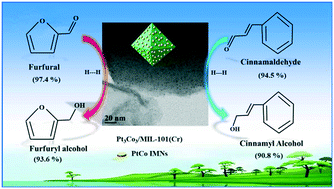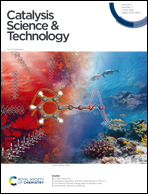Platinum and cobalt intermetallic nanoparticles confined within MIL-101(Cr) for enhanced selective hydrogenation of the carbonyl bond in α,β-unsaturated aldehydes: synergistic effects of electronically modified Pt sites and Lewis acid sites†
Abstract
Precious metals have been shown to play a vital role in the selective hydrogenation of α,β-unsaturated aldehydes, but still suffer from challenges to control selectivity. Herein, we have advanced the design of catalysts made out of Pt–Co intermetallic nanoparticles (IMNs) supported on a MIL-101(Cr) MOF (3%Pty%Co/MIL-101(Cr)), prepared by using a polyol reduction method, as an effective approach to enhance selectivity toward the production of α,β-unsaturated alcohol, the desired product. XRD, N2 adsorption–desorption, FTIR spectroscopy, SEM, TEM, XPS, CO adsorption, NH3-TPD, XANES and EXAFS measurements were used to investigate the structure and surface properties of our 3%Pty%Co/MIL-101(Cr) catalysts. It was found that the Co-modified 3%Pty%Co/MIL-101(Cr) catalysts can indeed improve the hydrogenation of cinnamaldehyde (CAL) to cinnamyl alcohol (COL), reaching a higher selectivity under mild conditions than the monometallic Pt/MIL-101(Cr) catalysts: 95% conversion of CAL with 91% selectivity to COL can be reached with 3%Pt3%Co/MIL-101(Cr). Additionally, high conversion of furfural (97%) along with high selectivity to furfural alcohol (94%) was also attained with the 3%Pt3%Co/MIL-101(Cr) catalyst. The enhanced activity and selectivity toward the unsaturated alcohols are attributed to the electronic and geometric effects derived from the partial charge transfer between Co and Pt through the formation of uniformly dispersed Pt–Co IMNs. Moreover, various characterization results revealed that the addition of Co to the IMPs can promote the Lewis acid sites that facilitate the polarization of the charge-rich C![[double bond, length as m-dash]](https://www.rsc.org/images/entities/char_e001.gif) O bonds and their adsorption via their oxygen atom, and also generate new interfacial acid sites.
O bonds and their adsorption via their oxygen atom, and also generate new interfacial acid sites.



 Please wait while we load your content...
Please wait while we load your content...
